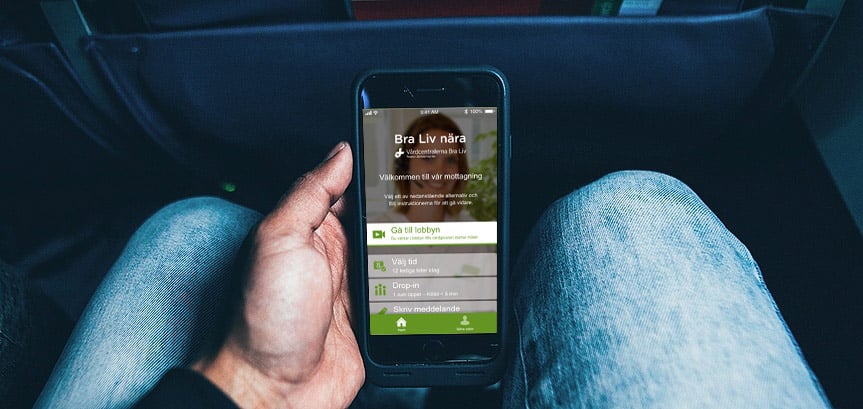We spoke with Ulf Österstad, doctor and business manager for Bra Liv nära. It is now just over two years since Ulf set up Bra Liv nära, Jönköping Region’s 32nd practice, which is completely digital. We were curious about what’s happened since and asked him to share his experience and insight.
What has happened since the launch?
When Bra Liv nära was launched in December 2015, it was the first publicly-funded primary care provider in Sweden, and perhaps even Europe, to begin offering digital care meetings. It’s encouraging that in a short amount of time, we’ve transitioned from something which seemed far off and visionary to a concrete reality. Our approach is starting to become established and the patients are finding us. We have just gone from being a project to constituting part of daily operations, and we are constantly building structures in order to continue to grow.
How do you work with Bra Liv nära?
Bra Liv nära is created by the region’s employees, for the region’s inhabitants. There are major advantages of scale to working this way. Today, we have 31 health Units which cover all of Region Jönköping, and now a doctor in Habo can help a patient in Gislaved. One of the advantages of centralisation is that the entire region can gain access to expertise which is otherwise linked to a single GP practice. One of our physiotherapists is a specialist in sports medicine, for example, and has played ‘A’ division floorball for 11 years. He can now be reached via the app.
Handling a county as a whole feels just about right. It’s big enough to provide advantages of scale to cover times and personnel categories, but small enough to allow us to keep track of all healthcare providers and guidelines.
“If you invest in integration before you have a good understanding of the service and the volumes, there’s a risk of doing it all wrong.”
-Ulf Österstad
We started with doctors, but now we also have physiotherapists, psychosocial support teams, and nurses. I don’t know where it will end – we’re allowing everyone who wants to try to do so and then we evaluate the results.
What would you say others should consider before opening a virtual clinic?
Have a good and clear dialogue with management so that the mission is clearly formulated. You need to start by creating a broad contact network with all stakeholders, both those within your organisation and external collaborators. Monitor the work going on in parallel around you and listen to the opinions of patients and healthcare workers alike.
Tell us a little about the users of your service!
We offer free advice from nurses who can guide patients to the right place. The patients can contact us from their summer house in Spain or any other location; we have access to their records so it doesn’t matter where they are.
Video consultations work very well for chickenpox patients, for example, who should not visit the health centre in person because of the risk of Infection. And a phone call isn’t really suitable, as you can’t see the rash. A video consultation to Bra Liv nära is, then, a very good solution.
How have you implemented the new approach?
When we work in Bra Liv nära we work in an agile way. This means that we work with what we believe is most effective and planning as we go along. During the time we have been active, we have changed the platform, staffing model, and local remuneration model. We are constantly proceeding through trial and error in order to be as effective and good as possible.
In healthcare, we have traditionally worked on the basis of long periods of time; some changes can take several years. First, the planning takes half a year, then the implementation phase takes at least one year. But in today’s reality, the conditions are constantly changing. Not everything is in place, things are changing all the time, and we need to have an agile approach and be quick on our toes so as not to fall behind. Naturally, it is a challenge to get everyone in the organisation on board. But the world around us is moving quickly. If everything needs to be planned in detail from the start, this means a long wait ahead, and when it’s time for the solution to be launched, it’s probably out of date already. That’s why it’s important to be bold and release things even if they are not 100% perfect and trust that they will be manageable nevertheless. If you’re just aware that some uncertainty exists, and can take this into account, then there’s no major problem. But this leads to an increased speed of development and you will more quickly arrive at a good product.
Can you tell us a little about how the security aspect works?
A lot of people currently question whether digital care meetings are safe. But then they are not making a comparison with the situation today in traditional care. Today there are a number of uncertainties, especially when it comes to telephone conversations where neither doctor nor patient undergoes ID checks. In digital care meetings, however, a bank ID is used as standard, and we also have multiple-encrypted video communication, which is more or less impossible to intercept. So we see many parts of digital healthcare as considerably more secure than current standards.

How integrated is Bra Liv nära in your other activities?
We have the same staff and guidelines for Bra Liv nära as for all other health care, which means that digital care is becoming integrated with the rest of the health care system. It is simple to switch the level of care and channel. Record keeping in the system is handled in the same way regardless of whether the patient contacts us via telephone, video or physical visit.
But sometimes I feel that the focus is on integration at far too early a stage. If you invest in integration before you have a good understanding of the service and the volume, there’s a risk of doing it all wrong. So it may be a good idea to look at what other sectors do, outside of healthcare. In other sectors, integration tends to come into play only once the volumes and needs have reached a certain level.
Which functions do you use?
Today, video is our primary source of communication, but we’ve also started using smart forms and asynchronous messages. I see great potential there. Patients have already been able to complete certain preparatory parts of the process asynchronously without the need for users to be on-site; e.g., book an appointment, describe their complaints and take photos. Now even more parts of the process will be manageable synchronously, as we can have a conversation with a patient via messaging and then switch between this and video.
Now even more parts of the process will be manageable synchronously, as we can have a conversation with a patient via messaging and then switch between this and video. We also have an interesting development project underway in which the patient – and perhaps, in the long term, a computer – can have a greater influence on the preparatory work. I think that we can even make reasonable progress in 2018, which feels really exciting.
How do you use smart forms?
The new form of service has many advantages. On one hand, it can be used as a form of triage, as questions and answers about problems help us to guide the patient to the right healthcare worker. On the other hand, the forms make it easier for patients to prepare for meetings by answering specific questions.
We have divided the form into 2 parts. In the first part, we want to capture the patient’s fears, expectations, and beliefs, so that we can find out in good time what the patient wants, and then be able to talk about that in particular during the consultation. In the second part, we create specific questions related to the complaints they are enquiring about.
How does your virtual clinic affect your workplace?
Many employees want opportunities for change in their workplace. Being able to work with remote consultations and serve the entire county contributes to variety and being able to do so from home provides an additional dimension. These opportunities make Bra Liv Nära an attractive workplace. It is important to find these types of values in times where it is not always possible to offer a higher salary.
Do you have any particular experiences that you want to share?
I have an employee who wanted to return to work after a burnout. But returning to your normal workplace with all the stress, workload, and requirements meant slow progress. However, the Bra Liv nära scheme meant that he could work at home, in his own safe environment, and he has now been promoted. It’s great that an individual can return to work on their own terms, but it also benefits society as a whole when we take care of our employees so that they can do as much good as possible.
Anything else you would like to add?
Many have said that I am courageous for running this, but I think my managers are the ones with courage; they inspire confidence. Often the manager’s manager will play the most important part; they’re the one bearing responsibility and standing behind you.


